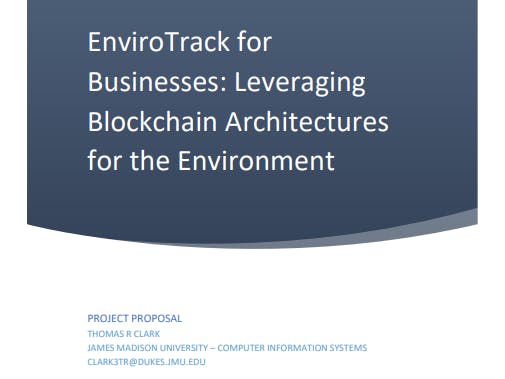What started as an undergraduate research project about vulnerabilities in blockchain surprisingly grew into a project about a potential software being used to allow businesses to better understand their environmental impact. This project involved researching blockchain architectures as well as thinking of a potential solution to business owners facing the problem of not knowing their ecological footprint. This potential software seeks to use blockchain architectures to solve this problem by creating a distributed, immutable ledger that is simple to implement and is cost-effective.Purpose and Introduction
Blockchain has become a prominent buzz word in recent times. With the rise of new cryptocurrencies and transactions occurring over the surface web and deep web, both individuals and businesses have made use of the technology. But what is blockchain? Simply, it is a database shared among computers in its network, in this sense, it is distributed. That database can hold data such as transactions, messaging, and medical data, to name a few. Additionally, data within a chain is meant to only be inputted, not removed nor edited. Because of this, many describe blockchain technologies as immutable. One of the main goals of this is that what a chain “says” happened, will be what a majority of the computers, or processing power in the chain agrees on. For example, if data in one computer is wrong, it will be automatically corrected to follow the majority.
Data in a blockchain network are stored in unique blocks which are assigned unique digital signatures. These digital signatures are used in order to validate data as well as prove to other computers in that network that the transaction is valid. For example, proving where the transaction came from as well as proof that it was not altered in transit. If information in a block is altered, any subsequent blocks after it are immediately invalidated (Sayeed & Marco-Gisbert, 2019). Additionally, these digital signatures are incredibly difficult to spoof, enhancing their security.
As it relates to the environment, many companies are utilizing blockchain technologies in order to work towards becoming more sustainable. Notably, in capturing and maintaining accurate data such as emissions, among other things. Businesses can then use this data in order to determine how to determine how to be more efficient and make more strides towards environmental sustainability. The problem that many firms are facing, however, is leveraging this technology to their advantage. Oftentimes, companies wanting to take these sustainability initiatives find themselves lost and unable to implement those solutions; either due to a lack of knowledge or a not enough time to implement the system.
Especially now, where many businesses are rewarded for environmentally conscious initiatives, there is more pressure, both economically and socially, than ever to utilize this technology. The purpose of this project is to propose a technology that solves this issue and provides a way for businesses to utilize this technology.
Proposed SolutionMeet EnviroTrack. Simply, EnviroTrack is a proposed enterprise-level software that allows businesses and individuals to leverage blockchain technology to understand their environmental impact more effectively. One of the most important aspects of this proposed software is its simplicity for those who are not blockchain literate to use. When implementing the software, the more technical aspects of blockchain (headers, hashing, etc.) are left to the configuration team and the end-user is able to clearly see their environmental impact. Specific metrics might include emissions from factories and water usage, among others. Additionally, companies and individuals should have the ability to customize this so that they are seeing metrics most relevant to their business needs.
The format for the software would ideally be a web-based app that users could access from anywhere (home, office, etc.). That way, it is convenient for users without needing to install any special software or be at a specific location. Additionally, most users are familiar with web-based browsers, making the software even simpler to use. However, if security is a primary concern for the company, the application should also be portable to a software that can be downloaded to local machines. That way, although being less accessible, the data will be less susceptible to attacks such as Cross-Site Scripting attacks (XSS) or SQL Injection attacks (SQLi) and as a result, be more secure.
There are multiple reasons as to why businesses would want to use a blockchain network for this data as opposed to traditional databases. As mentioned earlier, the data stored in a blockchain network is immutable. Once data is added, it cannot be changed or modified, this is useful especially for security concerns and ensuring data integrity. Additionally, because blockchain is distributed, businesses can track their data every step of the way to receive and maintain accurate records. These records can be updated in real-time as well, which provides individuals and businesses continuous monitoring of their operations.
The benefits of this application of blockchain are obvious: Businesses being able to view and maintain records of their environmental impact easily and in a matter that is simple to understand. Further applications of this technology might be useful for organizations reporting their emissions or other required information to regulatory agencies such as the Environmental Protection Agency (EPA); which require certain businesses to stay below a certain carbon threshold. Finally, the application of this technology is not limited by keeping track of environmental data. Sales, personnel records, among others can all be managed effectively by blockchain architectures.
User Interface Example
A user might see something like this when reviewing data about a company’s environmental impact. It is important that the data presented is neat and simple to understand.
Lin, I.-C., & Liao, T.-C. (n.d.). A Survey of Blockchain Security Issues and Challenges. 7.
Taylor, P. J., Dargahi, T., Dehghantanha, A., Parizi, R. M., & Choo, K.-K. R. (2020). A systematic literature review of blockchain cyber security. Digital Communications and Networks, 6(2), 147–156. https://doi.org/10.1016/j.dcan.2019.01.005
Sayeed, S., & Marco-Gisbert, H. (2019). Assessing Blockchain Consensus and Security Mechanisms against the 51% Attack. Applied Sciences, 9(9), 1788. https://doi.org/10.3390/app9091788
Blockchain Essentials. Blockchain Essentials | Free Courses in Data Science, AI, Cloud Computing, Containers, Kubernetes, Blockchain and more. (n.d.). Retrieved April 14, 2022, from https://cognitiveclass.ai/courses/blockchain-course
Zhang, R., Xue, R., & Liu, L. (2020). Security and Privacy on Blockchain. ACM Computing Surveys, 52(3), 1–34. https://doi.org/10.1145/3316481





Comments